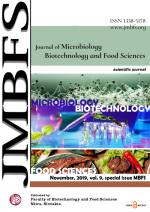NUTRITIONAL AND TECHNOLOGICAL PROPERTIES OF SELECTED KINDS OF COFFEE
DOI:
https://doi.org/10.15414/jmbfs.2019.9.special.400-403Keywords:
Coffea sp., roasting, fat, oxidative stability, antioxidant activity, polyphenolsAbstract
The aim of the study was to evaluate the quality indicators (moisture content, fat, ash, polyphenols and antioxidant activity) of seven samples of green coffee. The coffee samples were subsequently roasted, using the cinnamon roasting style. In the prepared roasted coffee, the same measurements were made as in the green coffees, in order to compare the samples and point out the changes taking place during roasting. In addition, oxidative stability was determined after the roasting process. The moisture content of the green coffee ranged from 7.4 % to 9.08 %, the ash content ranging from 2.53 % to 2.97 %, the fat content from 2.19 % to 6.33 %. The DPPH antioxidant activity ranged from 45.36 to 55.81 mg TEAC.l-1 (TEAC – Trolox equivalent antioxidant capacity) and total polyphenols from 511.44 to 618.11 mg GAE.l-1 (GAE – gallic acid equivalent). After the roasting process, the amount of dry matter (97.88 – 98.54 %) and fat (3.38 – 12.76 %) increased, the ash content did not change significantly. The most pronounced was the decrease in polyphenols, which is not surprising due to thermolabile substances. Overall, their values decreased of about 80 % compared to green coffee samples. Despite these losses, the samples showed a high antioxidant activity after the roasting process – 42.56 to 55.63 mg TEAC.l-1, which can be explained by the fact that during the roasting the Maillard reaction takes place, whereby new bioactive substances with antioxidant effect arise, on activity it also participates in vitamin B3, which is produced by thermal breakdown of trigonelline. The oxidative stability evaluated by the Rancimat method ranged from 1.2 to 10 minutes, suggesting that roasted coffee is susceptible to oxidation, therefore it should be milled just before preparation and serving.Downloads
Download data is not yet available.
Downloads
Published
2019-11-08
How to Cite
IvaniÅ¡ová, E., Czakóová, M., KaÄániová, M., & Tvrdá, E. (2019). NUTRITIONAL AND TECHNOLOGICAL PROPERTIES OF SELECTED KINDS OF COFFEE. Journal of Microbiology, Biotechnology and Food Sciences, 9(Special issue), 400–403. https://doi.org/10.15414/jmbfs.2019.9.special.400-403
Issue
Section
Biotechnology
License
Copyright (c) 2022 Eva IvaniÅ¡ová, Martina Czakóová, Miroslava KaÄániová, Eva Tvrdá

This work is licensed under a Creative Commons Attribution 4.0 International License.
All papers published in the Journal of Microbiology, Biotechnology and Food Sciences are published under a CC-BY licence (CC-BY 4.0). Published materials can be shared (copy and redistribute the material in any medium or format) and adapted (remix, transform, and build upon the material for any purpose, even commercially) with specifying the author(s).





